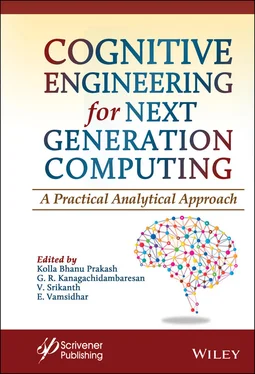Publishers at Scrivener Martin Scrivener ( martin@scrivenerpublishing.com) Phillip Carmical ( pcarmical@scrivenerpublishing.com)
Cognitive Engineering for Next Generation Computing
A Practical Analytical Approach
Edited by
Kolla Bhanu Prakash,
G. R. Kanagachidambaresan,
V. Srikanth, E. Vamsidhar

This edition first published 2021 by John Wiley & Sons, Inc., 111 River Street, Hoboken, NJ 07030, USA and Scrivener Publishing LLC, 100 Cummings Center, Suite 541J, Beverly, MA 01915, USA
© 2021 Scrivener Publishing LLC
For more information about Scrivener publications please visit www.scrivenerpublishing.com.
All rights reserved. No part of this publication may be reproduced, stored in a retrieval system, or transmitted, in any form or by any means, electronic, mechanical, photocopying, recording, or otherwise, except as permitted by law. Advice on how to obtain permission to reuse material from this title is available at http://www.wiley.com/go/permissions.
Wiley Global Headquarters111 River Street, Hoboken, NJ 07030, USA
For details of our global editorial offices, customer services, and more information about Wiley products visit us at www.wiley.com.
Limit of Liability/Disclaimer of WarrantyWhile the publisher and authors have used their best efforts in preparing this work, they make no representations or warranties with respect to the accuracy or completeness of the contents of this work and specifically disclaim all warranties, including without limitation any implied warranties of merchantability or fitness for a particular purpose. No warranty may be created or extended by sales representatives, written sales materials, or promotional statements for this work. The fact that an organization, website, or product is referred to in this work as a citation and/or potential source of further information does not mean that the publisher and authors endorse the information or services the organization, website, or product may provide or recommendations it may make. This work is sold with the understanding that the publisher is not engaged in rendering professional services. The advice and strategies contained herein may not be suitable for your situation. You should consult with a specialist where appropriate. Neither the publisher nor authors shall be liable for any loss of profit or any other commercial damages, including but not limited to special, incidental, consequential, or other damages. Further, readers should be aware that websites listed in this work may have changed or disappeared between when this work was written and when it is read.
Library of Congress Cataloging-in-Publication Data
ISBN 978-1-119-71108-7
Cover image: Pixabay.ComCover design by Russell Richardson
Set in size of 11pt and Minion Pro by Manila Typesetting Company, Makati, Philippines
Printed in the USA
10 9 8 7 6 5 4 3 2 1
Dedicated to our parents, family members, students and the Almighty.
Cognitive computing is a hardware and software element which is presently being used mainly in smart system development. Technologies such as artificial intelligence, machine learning, advanced analytics, natural language processing, big data analytics, and distributed computing come under the umbrella of cognitive computing. The impact of this technology can be seen in areas such as healthcare, business, decision-making, personal lives, and many more. Cognitive engineering is commonly used in analysis, design, decision-making, and sociotechnical systems; and cognitive physical systems are used in applications such as human–robot interactions, transport management, industrial automation, healthcare, agriculture, etc. Human individual interactions and group behavior are important to all these applications. Cognitive cyber-physical systems are applied in different areas such as smart manufacturing, agriculture, education, energy management, security, environmental monitoring, transportation systems, process control, smart cities and homes, medical healthcare devices, etc. The increasing complexity of cognitive computing also includes the security problems confronted by such networks. This rise of the Internet of Things (IoT) network complexity is due to too many devices being interconnected with each other through the internet along with the enormous amount of data originating from these devices. Also, novel security issues arise relating to the development of the IoT while conventional security issues become more severe. The major reasons for this are the heterogeneity and the substantially large scale of the objects. As the threats to IoT devices are increasing and the security metrics are based on the developmental aspects of software as well as network, the hackers can expand control and carry out malicious activities and attacks on other devices close to the compromised one. Due to the natural significance of the low-power and low-memory nature of these devices, these devices do not have malware protection or virus protection software. The cognitive approach to the IoT provides connectivity to everyone and everything since IoT connected devices are known to increase rapidly. When the IoT is integrated with cognitive technology, performance is improved, and smart intelligence is obtained. Different types of datasets with structured content are discussed based on cognitive systems. The IoT gathers the information from the real-time datasets through the internet, where the IoT network connects with multiple devices.
This book mainly concentrates on providing the best solutions to existing real-time issues in the cognitive domain. Healthcare-based, cloud-based and smart transportation-based applications in the cognitive domain are addressed. The data integrity and security aspects of the cognitive computing domain are also thoroughly discussed along with validated results.
EditorsKolla Bhanu PrakashG. R. KanagachidambaresanV. SrikanthE. Vamsidhar
We would like to thank the Almighty and our parents for their endless support, guidance and love throughout all the stages of our lives. We are grateful to our beloved family members for standing beside us throughout our careers, which are advanced with the editing of this book.
We would especially like to thank Sri. Koneru Satyanarayana, president of K.L. University, India, and Vel Tech Rangarajan Dr.Sagunthala R&D Institute of Science and Technology for their continuous support and encouragement throughout the preparation of this book. We dedicate this book to them.
Many thanks go to our students and family members who have put in their time and effort to support and contribute in some manner. We would like to express our gratitude to all who supported, shared, talked things over, read, wrote, offered comments, allowed us to quote their remarks and assisted in the editing, proofreading and design of this book throughout the journey to its completion. We also give our sincere thanks to the open dataset providers.
We believe that the team of authors provided the perfect blend of knowledge and skills that went into authoring this book. We thank each of the authors for devoting their time, patience, perseverance and effort towards this book; we think that it will be a great asset to all researchers in this field!
We are grateful to Martin Scrivener and all other members of the publishing team, who showed us the ropes to creating a book. Without that knowledge we would not have ventured into such a project. Their trust in us, guidance and the necessary time and resources afforded us, gave us the freedom to manage this book.
Читать дальше













